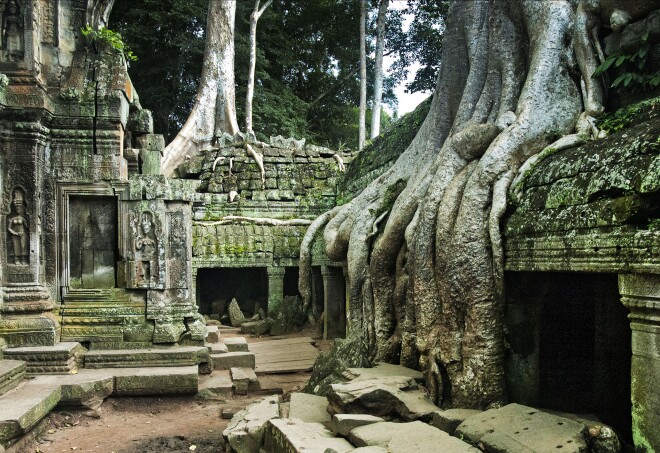If You Only Have 3 Days in Siem Reap
Three days will give you a taste of Siem Reap and its archaeological sites with time for a handful of other engaging experiences. Spend the first day focused on the star sights at Angkor Archaeological Park, like Angkor Wat and Angkor Thom, home to Bayon and Ta Prohm. On day two venture out to lesser visited temple ruins such as Koh Ker and Beng Mealea. On day three, do a cooking class and walking tour or floating village cruise. Spend your evenings seeing cultural shows, shopping and dining.
Krong Siem Reap, Cambodia
Crowds may swarm upon it daily from sunrise onwards, but exposure hasn’t dulled the impact of the largest religious monument in the world. Commissioned by King Suryavarman II in the 12th century as the centerpiece of the mighty Khmer empire, the structure is inspired by Hindu sacred design and is estimated to have taken around 30 years to build. The biggest surprise upon visiting might be learning that the vast complex of spires, moats, frescoes, cloisters, and balustrades was constructed in such speedy fashion. You won’t be alone while witnessing it, but sunrise over the iconic temple remains one of the essential experiences in Southeast Asia. A return in the afternoon when the camera-toting hordes have dispersed is also advisable.
Better known as the Tomb Raider Temple since its starring role in the Hollywood movie of the same name, Ta Prohm has at least as much star quality as Angelina Jolie. Cloaked in dappled shadow and locked in the embrace of the vast root systems that are still reclaiming it for the jungle, the temple is arguably the most atmospheric ruin at Angkor Archaeological Park. Construction on Ta Prohm began in 1186 C.E.; it was built in honor of the mother of King Jayavarman VII. Modern-day visitors are not permitted to climb onto the crumbling galleries of its 39 towers due to safety concerns. Nevertheless, picking a route around the various structures, close courtyards, and narrow corridors sprouting with lichen, moss, and creeping plants is one of the most enthralling experiences at Angkor.
Pub Street Area , Mondol 1 Village 284, 2 Thnou St, Krong Siem Reap, Cambodia
While cute souvenir shops and even haute couture boutiques exemplify the changing face of the retail scene in Siem Reap, the city’s famous Old Market remains a heady hub of traditional trade and commerce. Located right in the heart of town, Psar Chas is amply stocked with lots of things that you might want to buy—as well as plenty of things you probably do not. That said, perusing the labyrinthine aisles full of silverware, silks, handicrafts, spices, stone carvings, and other assorted ephemera is worth a couple hours of anyone’s time. Stay calm and haggle politely with a smile on your face, and you’re sure to find a bargain or two.
Opposite Pannasastra University, Street 27, Krong Siem Reap, Cambodia
The Sugar Palm restaurant is the first Cambodian restaurant that many visitors to Siem Reap try, and it often becomes a favorite. The food is some of the most delicious, traditional, home-style Cambodian food in the country. It also happens to be served in a very traditional, Khmer teak-wood house, with high ceilings and wide verandahs—oozing atmosphere.
Everything on offer is scrumptious, from the amok trei or fish amok, to the hearty Cambodian chicken curry. If you’re not a fan of pungent and sour flavors but want to try one of Cambodia’s quintessential ingredients, prahok (fermented fish), then this is the restaurant to do it. The prahok k’tis (a minced pork dip made with prahok) is a fairly tame albeit still very tasty iteration of the dish. The owner-chef, Cambodian-New Zealander Kethana Dunnett, is often around if you have questions about the cuisine. Kethana is the go-to person for celebrity chefs -- from Gordon Ramsay to Luke Nguyen -- when they are in the country filming food programs, and she certainly knows her stuff.
Everything on offer is scrumptious, from the amok trei or fish amok, to the hearty Cambodian chicken curry. If you’re not a fan of pungent and sour flavors but want to try one of Cambodia’s quintessential ingredients, prahok (fermented fish), then this is the restaurant to do it. The prahok k’tis (a minced pork dip made with prahok) is a fairly tame albeit still very tasty iteration of the dish. The owner-chef, Cambodian-New Zealander Kethana Dunnett, is often around if you have questions about the cuisine. Kethana is the go-to person for celebrity chefs -- from Gordon Ramsay to Luke Nguyen -- when they are in the country filming food programs, and she certainly knows her stuff.
812, Kampong Phluk, Cambodia
Kompong Phluk is a floating village located in the middle of Cambodia‘s largest lake, Tonle Sap. The term “floating” is a bit misleading: the houses are actually built on very tall stilts around 8 meters high. During the rainy season, the lake rises and covers the stilts, giving the illusion that the homes are floating in the water. We learned that these types of villages are built in the middle of the lake to make it easier for fishermen and rice farmers to gather during harvest season.
Banteay Srei, Cambodia
The 10th century temple of Banteay Srei, known as the ‘Citadel of Women’, is one of the prettiest temples with intricately detailed carvings and decorative features painstakingly carved into the pink sandstone. It’s also one of the most compact and can easily be explored in an hour or two. You can make a day trip of the journey out there (25km from Siem Reap) by combining it with visits to the nearby Landmine Museum and Banteay Srei Butterfly Centre.















